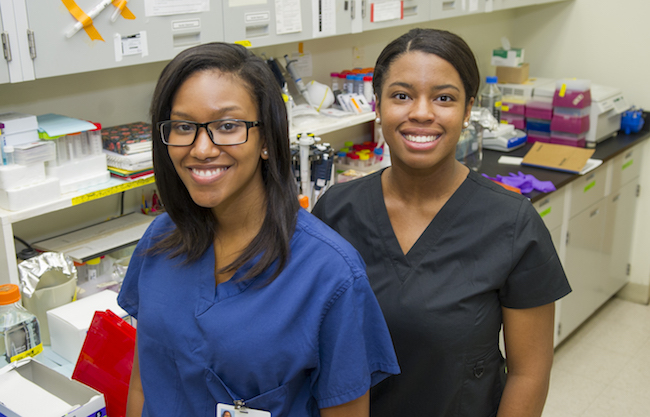A taste of research: Part 2

Research took center stage this summer for participants in the Predoctoral Student Research Program at Texas A&M College of Dentistry, who spent eight weeks working in labs around campus. For a behind-the-scenes glimpse, we asked three groups of student researchers to give us their take on their experiences. Enjoy Part 2 of this three-part series.

Francesca Daigle and Gelise Porter
Faculty mentor: Dr. Xiaofang Wang, assistant professor, Department of Biomedical Sciences
Incoming dental students Francesca Daigle and Gelise Porter have spent eight weeks this summer assisting with research centered on a gene known as FAM20B.
“Our research suggests that proteoglycans, a group of molecules that were believed to be structural molecules in the extracellular matrix, are actually important mediators of the signaling that governs tooth, limb and finger development,” says Daigle and Porter’s faculty mentor Dr. Xiaofang Wang.
“This finding opens a new window for us to understand the complex mechanism underlying the morphogenesis of these organs and lays a foundation for developing regenerative and therapeutic strategies in future studies,” Wang says.
The students used genotyping, a process of determining an organism’s genetic makeup, to identify DNA from different mice lines and assisted in immunohistochemistry – the identification of specific tissue components – by sectioning and treating samples in preparation for staining, which allows the researchers to examine the expression pattern of an uncharacterized protein to infer its function.
Daigle is participating in additional studies regarding an uncharacterized gene related to bone and tooth development, drawing on previous research experience in polymer chemistry as an undergraduate student at the University of Texas at Dallas. This biological research technique is intriguing, she says.
“I’m excited to see how this research applies to the field we’re looking to enter, to have the techniques I learned previously be translated to a setting where you can use them to further your understanding about dentistry,” Daigle says. “There are many steps involved in procuring this data and each step must be done well in order to get to the final results.”
Porter earned her bachelor’s degree at Oglethorpe University in Atlanta and is working in a research lab for the first time.
“I’ve taken science courses and learned the basics, where you operate under a very defined set of procedures,” she says. “It’s interesting to see how the experiments we’re doing now are put together to discover new findings. It deepens your understanding of what you’re trying to accomplish by applying them to a research goal and using them to obtain data.”
Both students have learned to adapt when necessary.
“In a lab setting you know how things should work, but do they work like that every time? No, they don’t,” Daigle says.
Porter adds, “Sometimes procedures have to be changed in the real world, and I’m seeing how they are used to get to an end point.
We are very excited to be part of this research and to aid with further insights to come.”